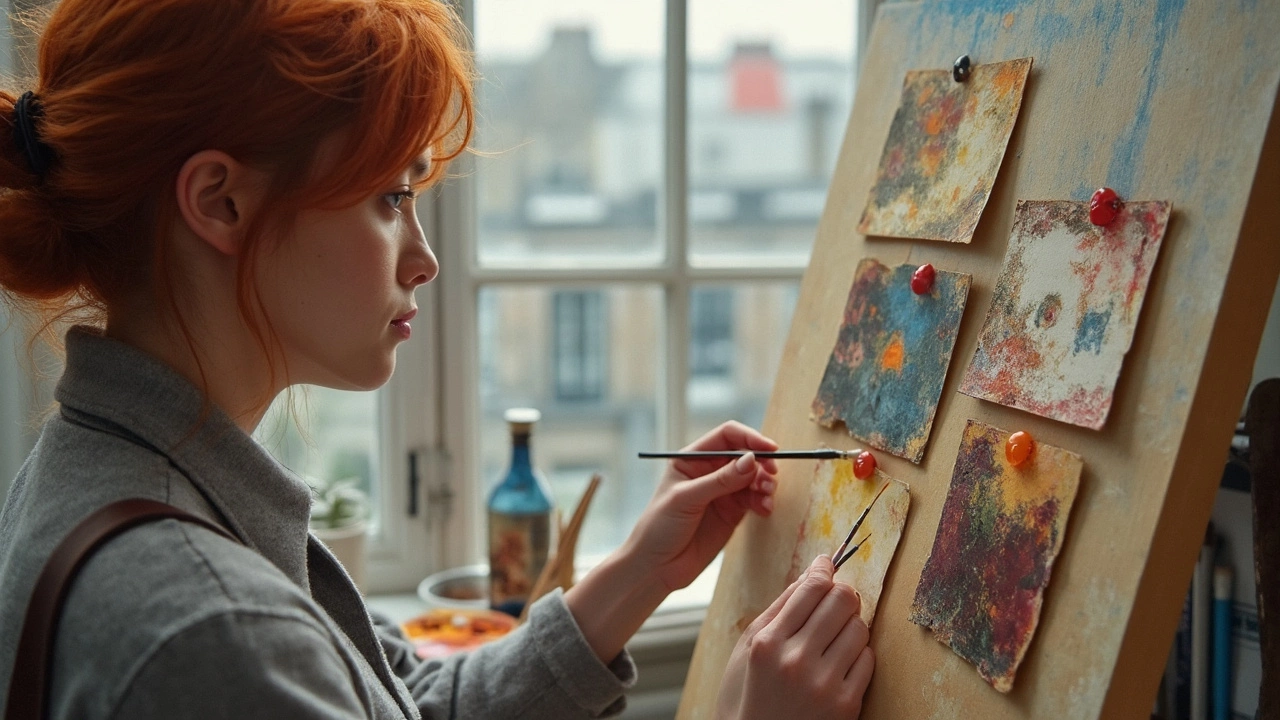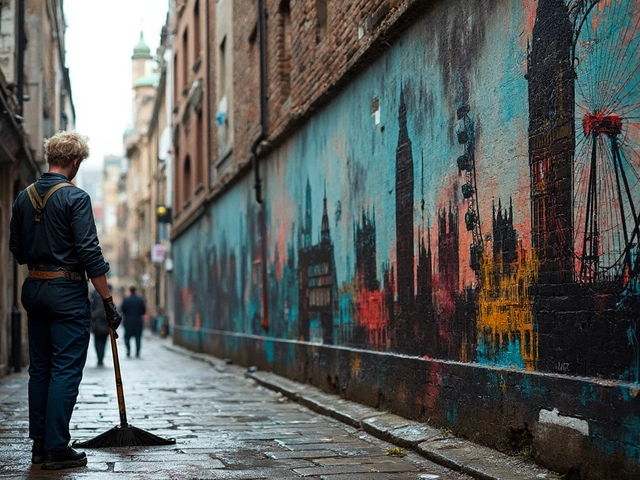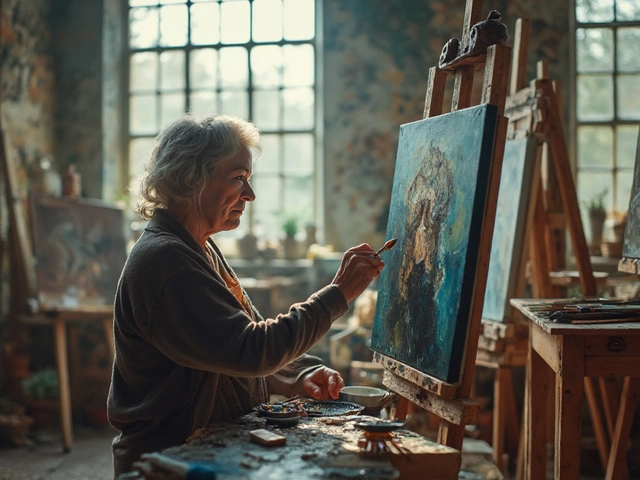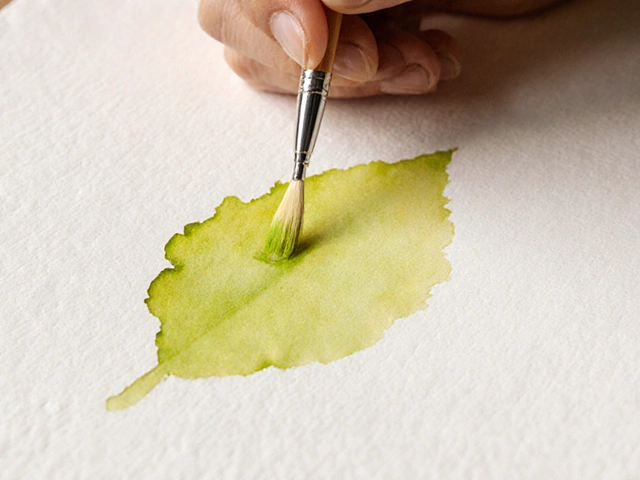Oil painting isn’t just grabbing a brush and hoping for the best. There are three key rules that help your paintings stay solid and look the way you imagined. If you ignore them, your paint might crack, colors could get muddy, or you’ll end up waiting forever for a layer to dry—yep, been there, done that, and my cat Whiskers was not impressed with the mess.
The good news? These three rules are super straightforward once you know what they actually mean. They aren’t complicated, and you don’t need loads of art jargon to follow them. Once you get them down, you’ll spend less time fixing weird problems and more time actually painting. Let’s get into why these rules matter and how they’ll save your next canvas from a sticky, regret-shaped disaster.
- Fat Over Lean: What It Means and Why It's Key
- Thick Over Thin: Layering Without the Mess
- Slow Drying Over Fast: Timing for Lasting Results
- Real-Life Tips and Myths Busted
Fat Over Lean: What It Means and Why It's Key
If you hear "fat over lean" and picture food, that's not where we're going. In oil painting, it’s about how much oil is in each layer of paint, and this rule decides if your art survives or cracks. "Lean" means paint mixed with less oil—usually just paint plus a bit of solvent like turpentine. "Fat" means you add more oil (like linseed or walnut oil). Simple, right?
The idea is this: every new layer should have a bit more oil than the one below it. That way, the layers dry at the right pace. Oils take time to dry, and more oil = slower drying. If the top layer dries slower than the one beneath it, you avoid paint cracking and flaking off later. Ignoring this rule is the #1 reason paintings from beginners start peeling after a year.
- Lean (less oil): Use for your first thin layers, often right after blocking in basic shapes.
- Fat (more oil): Use in your upper layers, for highlights and details.
Here’s the catch: too much oil in lower layers, and your paint shrivels or cracks like desert mud.
Most artists just add a few drops of extra oil into each new mix as they build layers. If you use store-bought mediums (like Winsor & Newton’s Oil Painting Medium), check the label—many are already "fatter" than straight paint. A small notebook or even writing directly on your palettes can help keep track of which mix you used last.
| Layer Type | Oil to Paint Ratio | Drying Speed |
|---|---|---|
| Lean (Underpainting) | 1:5 oil to paint | Fastest |
| Medium (Mid-layers) | 1:4 oil to paint | Moderate |
| Fat (Final layers) | 1:2 oil to paint | Slowest |
Makes sense, right? The goal: stable, uncracked artwork that’ll last, not fall apart on the wall after you finally hang it up. If you’ve ever seen old paintings with a spiderweb of cracks, this rule was probably ignored. Once you get "fat over lean" into your routine, you’re ahead of the game.
Thick Over Thin: Layering Without the Mess
This rule sounds like a baking tip, but it’s actually about keeping your oil painting looking sharp and not like it’s having a meltdown. Basically, you want to lay down thin paint first and build up to thicker paint in your top layers. Why? Thin first lets the first swipe of paint dry and stick right to the canvas, while thick paint on top gives you texture and that classic, juicy finish.
Here’s the deal: if you flip this and put thick, oily paint underneath, and thin, fast-drying stuff on top, your paint can actually crack, wrinkle, or peel later on. The bottom layer keeps moving while the top dries, and that’s where things go wrong. Strangely enough, this cracking might not show up for months, sometimes even years. Imagine finally getting brave enough to varnish your painting, and—boom—cracks all over. Seen it happen. It’s a nightmare.
So, how do you layer paint the right way?
- Start with paint thinned with solvent (like odorless mineral spirits or turpentine) and not much oil—this gives you those lean, quick-drying base layers.
- Each next layer should have a bit more oil medium (like linseed oil or stand oil), making it thicker and slower to dry.
- As you move up, you can push that thick paint with a palette knife or even layer with heavy brushstrokes for bonus drama.
If you’re using commercial paints, most tubes fresh out of the box are already designed to work for middling layers. But for super-thick effects—the type where you could lose a cat hair in the paint—use paints straight from the tube with added medium only in the top layers.
Not sure how your layers are stacking up? Here’s a quick guide on common tools and paint thicknesses:
| Layer | What to Use | Expected Thickness |
|---|---|---|
| 1 (Base) | Thin paint + solvent | Very thin, almost like watercolor |
| 2 (Mid) | Paint + small amount of oil | Smooth, barely raised from canvas |
| 3 (Top/Detail) | Paint straight from tube or with more oil | Thick and textured, brush marks visible |
This "thick over thin" routine holds firm whether you’re doing a detailed portrait or a messy, abstract night. Stick with it and you won’t get those dreaded cracks. Plus, you’ll get way more pop in your top highlights—it’s like the cherry on your pizza. If you ever spot artists laying it on thick from the start, trust me, their paintings probably don’t last the way they should.

Slow Drying Over Fast: Timing for Lasting Results
Ever noticed your oil paintings end up wrinkly or the top layer cracks months later? This usually happens if you rush the drying time, ignoring one of the biggest rules in oil painting: always put slower-drying layers over faster-drying ones. It sounds boring, but it’ll save your masterpiece from falling apart—literally.
Oil paint dries in a weird way. It actually hardens from the top down, not from the bottom up. So, if you trap fast-drying paint under slow-drying paint, the top can harden and shrink before the bottom gets a chance to set, causing cracks you can’t fix. Good news is, you don’t need a chemistry degree to handle this—just a bit of patience and timing.
Here’s how you keep things smooth and lasting:
- Start with layers that dry fast—like underpaintings with paint thinned by turpentine or odorless mineral spirits.
- Add more oil or use less solvent in later layers so those layers take longer to dry. This helps everything dry at a steady pace.
- If you mess up and paint a slow-drying color under a fast-drying one, take it off and redo. It’s a pain, but less painful than fixing cracks after the fact.
Want to see how long popular paints actually take to dry? Check this quick table:
| Color | Average Drying Time* |
|---|---|
| Burnt Umber | 2-3 days |
| Raw Sienna | 2-3 days |
| Cobalt Blue | 2-5 days |
| Cadmium Red | 5-7 days |
| Titanium White | 5-10 days |
| Alizarin Crimson | Up to 14 days |
*Based on thin layers at room temperature; thicker paint and colder rooms take longer.
Some artists use drying mediums like Liquin or alkyds to speed up the slow ones, but don’t overdo it. If you try to force everything dry, you’re risking the same sort of cracking and shrinking issues, just on a faster timeline. If you ever need something dry enough to work over, stick your canvas in a warm, dry room (not in direct sunlight though—just trust me on this one).
Bottom line: oil painting is more of a slow burn than a sprint. Give each layer the time it needs, and your paintings will stay vibrant and crack-free for years. Even if Whiskers jumps up and knocks into them, at least you know they won’t flake apart.
Real-Life Tips and Myths Busted
Every time you search for advice about oil painting, you’ll find a lot of rules—and just as many myths. Let’s clear things up with real talk from the studio, plus some tips you can use right away.
First up, don’t let anyone tell you that expensive brushes or paints are required to make a good painting. Sure, high-quality materials can help, but technique matters more. The famous artist Bob Ross used house painting brushes. No joke.
- Keep your lids clean. Oils dry slowly, so brush handles and palette lids get sticky fast. Wipe things down as soon as you finish, and you'll spend less time digging dried paint out of screw threads.
- Don’t wait for one layer to be fully dry unless you need to. Layers don’t always need to cure for weeks. As long as the surface isn’t tacky or soft, you’re usually okay to go on with the next step. For detail work, a little bit of wet paint can even help with blending.
- Test new stuff on scrap first. Whether it’s a new medium, brush, or canvas, try it out before you put it on something important. Some oils or solvents mess with drying time or color in a way you don’t expect until it’s too late.
Now for a few busted myths:
- “Oil paintings take years to dry.” Most layers are dry to the touch in days, not years. Turpentine thins paint to dry faster. Thick globs can take longer, but nobody’s waiting until 2030 for their first coat to set.
- “White paint always cracks first.” Cracking usually happens when you ignore the fat-over-lean rule, not just because it’s white. Any color can crack if the bottom layers dry faster than the top.
- “Natural light is the only good studio light.” Good lighting is critical, but LEDs or daylight bulbs work fine if you can’t chase the sunlight around the house.
One extra tip: if your house has pets, don’t leave oil paintings where tails or fur can get into the wet paint. Whiskers learned this the hard way, and so did my favorite black hoodie.
Stick with the essentials, watch out for these common traps, and the process gets easier. Don’t fuss too much about what’s “right” or fancy; those basics actually do most of the heavy lifting.





